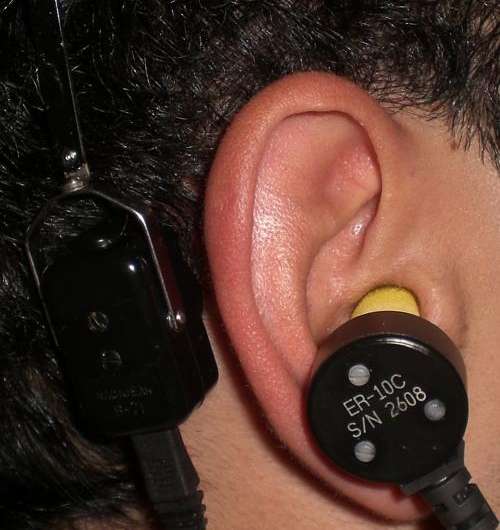How an objective audiometric test can become even more reliable

Not only can the human ear detect sounds, it can also generate them. If the ear hears the two upper tones of a major triad, it produces the fundamental of the chord which can then be measured. This phenomenon, called "otoacoustic emission" (OAE), is used by otologists for objective audiometric tests, e.g. in newborns. Investigations at the Physikalisch-Technische Bundesanstalt (PTB) have shown that an OAE audiometric test becomes even more reliable if the two sounds are transmitted to the ear not via a loudspeaker, but by bone conduction.
Regardless of where people come from, whether they are Europeans or Asians, the human ear is always tuned to a major scale. If the ear hears the two upper tones of a major triad, the ear itself produces the third, lowest, tone of the chord. This tone is called "distortion product otoacoustic emission (OAE)" and is generated due to anatomic and physical laws: if the hair cells in the inner ear are healthy and sound, they are stimulated by the two matching tones to vibrate at a third frequency. This lower tone comes out of the ear again and can be measured by means of a highly sensitive microphone. With the aid of this phenomenon, it is possible to check objectively whether the hearing of newborns or infants is intact.
Such a test used to be performed using two tiny loudspeakers, each of which emitted a tone into the ear, as well as a miniaturized microphone, which recorded the third tone (if it came out at all). If this tone is not generated, physicians have a first inkling that the baby might need therapy or a hearing aid. However, it may be that the ear is healthy but does not "hum". This can be caused by a badly calibrated loudspeaker, or due to the fact that the loudspeakers which are placed close to each other emit standing waves into the auditory canal which weaken one of the two tones.
To preclude such malfunctions, alternative tone generation methods have been investigated at PTB within the scope of a DFG project: so-called "bone vibrators" which, in analogy to a tuning fork set onto the bone, convey the tone directly to the bone located behind the ear. The results have shown that both with two bone vibrators and in combination with a loudspeaker, correct otoacoustic emissions are generated. This not only allowed calibration errors to be reduced, but also provided physicians with improved differential diagnosis possibilities, since with the new procedure, they can test the function of the inner ear without a doubt and, potential damage of the middle ear, thus, has less influence. Clinical studies should follow.
More information: Zebian, M. Calibration of Distortion Product Otoacoustic Emission Probes. Dissertation, TU Braunschweig (2012).
Provided by Physikalisch-Technische Bundesanstalt


















